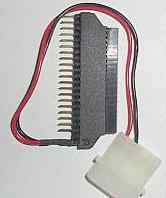 home
home manual & docs
manual & docs drivers & updates
drivers & updates software
software GNU/Linux
GNU/Linux Introduction
Introduction Read this
Read this What you need to know about the aero
What you need to know about the aero Partitioning the harddisk
Partitioning the harddisk Choosing the installation method
Choosing the installation method Preparing the Aero for a Red Hat 6.1 harddisk install
Preparing the Aero for a Red Hat 6.1 harddisk install The Red Hat 6.1 Installation Process
The Red Hat 6.1 Installation Process RAM-problems
RAM-problems The Floppy
The Floppy Access to DOS-Partitions
Access to DOS-Partitions The Linux-BootLoader
The Linux-BootLoader Configuring X-Windows
Configuring X-Windows Patching and compiling a new kernel
Patching and compiling a new kernel Solving the RAM problem
Solving the RAM problem Installing PCMCIA and configuring it for Bad RAM
Installing PCMCIA and configuring it for Bad RAM Finished - What comes next?
Finished - What comes next? Advanced Power Management
Advanced Power Management Getting WebDAV to work with XP
Getting WebDAV to work with XP Conclusion
Conclusion GNU Free Documentation License
GNU Free Documentation License FreeDOS
FreeDOS internal speaker
internal speaker the press
the press the people (& their mails)
the people (& their mails) the aeros wildest dream...
the aeros wildest dream... links
links about
about

Unplugged?
In this chapter I describe the different installation possibilities I used. It contains:
To unplug the aeros harddisk and plug it into a desktop pcTo install from harddisk
Experiences with installations from harddisk
I have no external cd-rom, neither on the pcmcia nor the parallel port. I also was a newbie when I installed it and knew nothing about setting up a NFS Network between two linux-machines.
So that left only two possibilities:
I will first describe these two ways of installing linux to the aero and the difficulties I found. In the next chapter I describe a harddisk install of Red Hat 6.1, because this was my first successfull installation. While I did that I wrote down all my steps - most parts of this site result from those writings.
I must admit that in the meantime I deleted Red Hat 6.1 and replaced it with 7.1 plus all the upgrade files which make it more similar to Red Hat 7.3 or 8. The reason was that the 7.1 Red Hat version is still good supported and I had it by hand. I did this by plugging the aero's hdd into the desktop - I found out that this is all in all much easier and faster.
Plugging the aeros harddrive into the desktop

What sounded the hardest way to install linux turned out to be the easiest one. The only thing you need it is an adapter for connecting the laptop harddisk with your desktop cable.
On the picture left you see the adapter needed for that.
I was already well prepared, because I already changed the original 250 MB Quantum disk into a bigger one, so I knew how to open up the aero and unplug the harddisk.
For those who do not know those things: look at the aerofaq and the webpage of Markus Gebhard who describes this very clearly at http://www.stud.uni-karlsruhe.de/~ukgh/aero/open/open.htm.
Be sure to install the aeros harddisk as the only primary hd in your desktop system i.e. unplug all your other harddrives from the desktop. This avoids linux to give the harddrive partitions names (hdb or hdc) which will not match when you plug it back into the aero. In the aero the hdd is the only drive and so the partitions are all called hda1, hda2 and so on.
Remember that you need additional software for the aero, the installation disk is not enough. What you definitely need is the BadRAM-patch because after the installation you need to patch the kernel to the needs of the aero. So go into the internet before doing all the unplugging and plugging and get the BadRAM-kernel patch, that fits to the kernel the distribution comes with. If there is no patch for the kernel the distribution comes with, you also need another kernel file to install it by hand.
Save it either to the aeros harddisk or to floppy. Remember that you can't surf the internet whith the desktop while the aeros harddisk is plugged inside. So if you need information from the internet (like this site) or the kernel how-to (for looking how to install and patch a kernel) print it or have a third computer at hand for websurfing these sites.
After the installation get a new kernel, unpack it, patch it, configure it and install it and all the needed modules. I describe the way I did that in a chapter a little bit further. Then you may put the aero's hdd back into the aero again. Linux should now boot without problem on the aero. There are some additional things to install like the pcmcia-cs package to make the aero detect the pcmcia-slot. You will notice that installing software on the aero is MUCH slower than on a desktop (and my desktop is only a pentium 200...).
Installation from harddisk
Like I described in the previous chapter: A harddisk installation means that all installation files lay on the harddisk. So you need:
The necessary installation files in the right format (special directory copied from the installation cd or cd-image like described by the distribution).
Enough free space on the harddisk (depends on what you want to install. 1,7 GB would be fine for a big distribution like redhat or debian but you may come out with much fewer space - or need much more). Additionally you need space for the installation files (600 MB for one cd).
In many cases the partition you want to copy the installation files onto needs to understand long filenames. So you need a filesystem like vfat (Win 95) or ext2. The vector-linux files may come out with 8.3 filenames.
A connection between your desktop pc and the aero. That may be a network connection or connection over the parallel port. Take care: In distributions like Debian or RedHat the installation files don't have 8.3 filenames. So you can not cannot use winlink because it will cripple all filenames. You may use the shareware LinkMaven or the 30-day-demo of winlink 2000 instead which have no problems with long filenames.
I had windows 95 with an installed network running on the aero so getting the files there via network was no problem.
If you have no network or lpt-connection you may use also floppys. Because this will need much time I would suggest to pull out the harddisk and do all the things mentioned in the last chapter - this is much easier to do.
Experiences with installation from harddisk:
Vector Linux
debian woody
Red Hat 7.1
Red Hat 6.1 (next chapter)
Comments
Suggestions for this page? Ideas? Please drop a note!
Don't forget to add your email, if you appreciate a personal reply.
The comments are sorted from date.